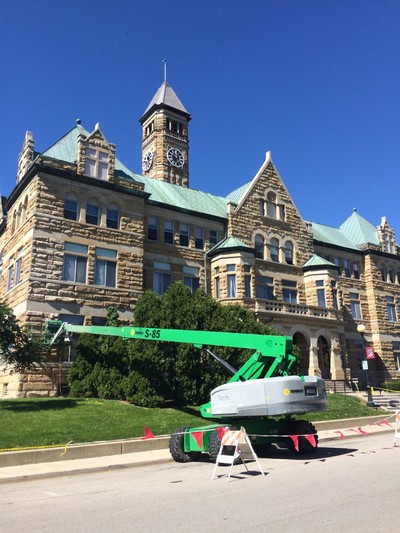
ST. LOUIS, Mo. – Busy traffic, a steady flow of visitors and unique materials were among the challenges Western Specialty Contractors faced when it restored the stone façade of Charleston, Illinois’ historic Coles County Courthouse.
Located in the public square in central Charleston and housing most of Coles County’s important administrative offices and courts, the courthouse is one busy facility. Western Specialty Contractors was contracted to restore the building’s stone façade, including its four corner pavilions – each over 40-feet tall. The architect on the restoration project was Hance Design Group.
Built in 1898 and designed by architect Cornelius W. Rapp in the Richardsonian Romanesque style, the Coles County Courthouse features a clock tower at its center, four main entrances and a façade constructed of brownstone from the Embarras River. Noted as the courthouse where President Abraham Lincoln tried several civil and criminal cases as a young attorney, the building was added to the National Register of Historic Places in 1978.
The first challenge crews faced on the project was removal and replacement of the large, heavy stone pieces near the top of the pavilions. Western worked with the architect to prepare shop drawings to show coursing that would allow crews to use more manageable-sized stones as replacements, rather than utilizing the large, original stone pieces. This technique allowed the crews to move the stone to the top of the building using a man lift rather than a crane, which would have required traffic be blocked off around the busy courthouse.
Western also made a conscious decision to use two, 85-foot lifts rather than a single 45-foot lift to access the façade. The two, longer lifts could be placed in parking spaces along the perimeter of the street to reach the work areas, going up and over an underground holding area beneath the courthouse lawn, which posed a risk of collapse if equipment were placed on it.
When it came to color-matching for the stone patching, crews faced another challenge; an exact match would be difficult to achieve due to the variation of coloring throughout the stone. In order to achieve a close match, crews created nine separate color mock-ups, assisted by Cathedral Stone, which supplied the stone material for the mock-ups. Where new stones were needed, crews were able to find replacement stones that closely matched the originals.
A final challenge on the project involved the mortar joints, which were not able to be removed to the correct depth with a standard grinder due to the stone face protruding past the mortar joint. Crews found a solution by removing as much of the mortar as possible with a grinder, then chiseling out the remaining mortar by hand to achieve the proper depth.
In total, crews performed more than 25,000 lineal feet of tuckpointing; removed and replaced nearly 200 stones from the corner pavilions using four different sizes of stone; performed 150 square feet of stone patching at various depths and cleaned 20,000 square feet of stone façade. Western completed 75 percent of the tuckpointing work in the fall, then completed the balance of the work in the spring.


 Join our thriving community of 70,000+ superintendents and trade professionals on LinkedIn!
Join our thriving community of 70,000+ superintendents and trade professionals on LinkedIn! Search our job board for your next opportunity, or post an opening within your company.
Search our job board for your next opportunity, or post an opening within your company. Subscribe to our monthly
Construction Superintendent eNewsletter and stay current.
Subscribe to our monthly
Construction Superintendent eNewsletter and stay current.